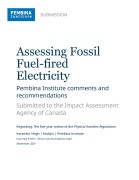Dear Minister Guilbeault,
On behalf of the Pembina Institute, I would like to thank you for the opportunity to provide input into Canada’s 2035 emissions reduction target. With this letter, I am summarizing our position, which calls for an ambitious 2035 target that enables all stakeholders across the country to take the bold yet necessary action required to get to this critical milestone on the pathway to net-zero by 2050.
In responding to the accompanying survey, we have advocated for a faster pace of change between now and 2035.The 2035 target should take into consideration Canada’s anticipated shortcoming in reaching the 2030 target. While Canada appears to be on track to achieve an emissions reduction of 36% below 2005 levels by 2030, this still falls short of the enhanced target of a 40 to 45% reduction. All sectors of society and the economy need to do more—and there are clear benefits to doing so. Not only will we help avert the worst of climate change as the science tells us we must, we also have a generational opportunity to enhance Canada’s competitiveness in the global economy while securing good-paying jobs, improving the health of citizens, and making energy more affordable.
Our preference for an ambitious 2035 target is based on a vision for a pathway to net-zero that will:
- put people first, prioritizing systemic change in the economy for the benefit of all;
- are anchored in science and respect a carbon budget;
- prioritize early, deep, sustained, technologically feasible reductions in every sector; and
- include an appropriate role for carbon removal and offsets.
We believe that achieving an ambitious 2035 target will take an equivalent level of effort from both federal and provincial governments while acknowledging the importance of setting national standards. In the meantime, the federal government must remain committed to the Green Buildings Strategy to transition heat systems off fossil fuels and improve energy efficiency. It’s also imperative to stay the course with Electric Vehicle Availability Standard, requiring that at least 20% of new light-duty vehicles offered for sale be ZEVs by 2026, at least 60% by 2030, and 100% by 2035.
Pembina has identified areas where more action is needed from the federal government. We encourage the federal government to fully implement the emissions cap on the oil and gas sector, the Clean Electricity Regulations and the methane regulation amendments. It is urgent to complete clean electricity Investment Tax Credits (ITCs) for public and private projects, strengthening the business case for clean electricity investments. We recommend bringing the carbon, capture, utilization and store (CCUS) ITC into law to support emissions reduction activities.
It’s time to revise the Output-Based Pricing System (OBPS) to require full pricing of all electricity sector emissions in all provinces to procure tonne-for-tonne negative emissions for the residual emissions. We recommend a comprehensive reassessment of provincial OBPS equivalency agreements with a sector-specific approach to ensure broad economy-wide decarbonization.
Given that a clean grid will eventually provide more affordable electricity than current grids, extra government effort is needed during this transitional period to monitor and assist Canadians facing affordability issues, and this should include not only electricity, but all sources of energy and other staples Canadians rely on.
In light of the considerable impact and opportunities of the energy transition on workers, it’s time to pass the Sustainable Jobs Act and rapidly follow through with the associated enabling infrastructure. Our Sustainable Jobs Blueprint highlights the opportunities that a net zero economy offers workers. Modelling undertaken shows that the path to net zero will result in at least two million direct and indirect clean economy jobs by 2050.
We look forward to working with your ministry and other departments of the Government of Canada to build upon the impressive progress already made in this country to position us a clean energy leader, with the widespread prosperity, affordability of energy, public and private sector innovation, and increased equity that the transition makes possible.
Yours sincerely,
Chris Severson-Baker
Executive Director
Pembina Institute








